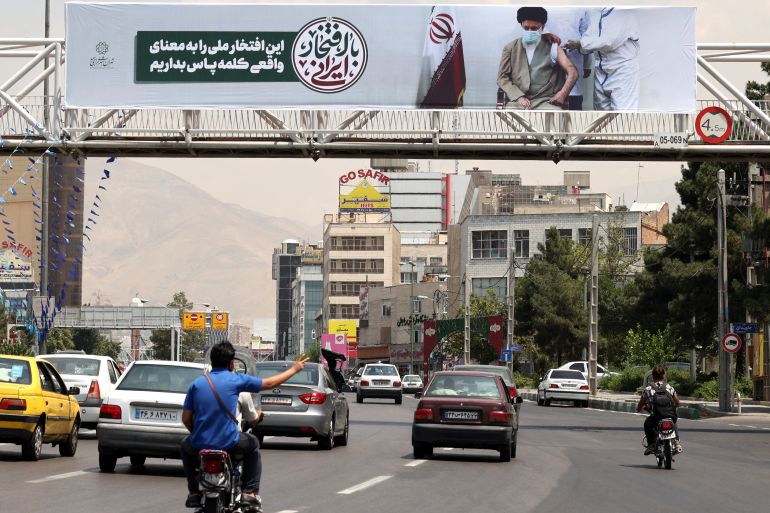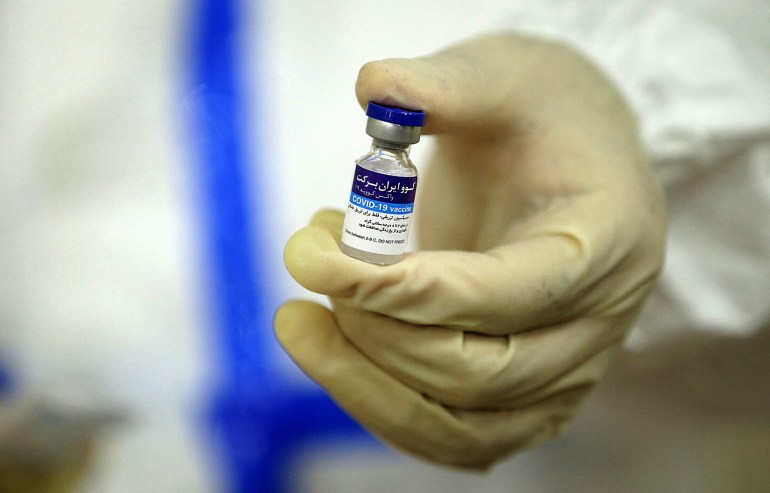Iran locks down capital amid COVID surge ahead of Eid holiday
Six-day lockdowns imposed ahead of Eid al-Adha holiday as Delta variant drives Iran’s fifth major wave of infections.

Tehran, Iran – Provinces of Tehran and neighbouring Alborz have been put under lockdown by the Iranian government for six days starting on Tuesday as COVID-19 cases have risen sharply ahead of Eid al-Adha holidays.
Iran celebrates the Muslim holiday on Wednesday and the following two days are the country’s weekend, which usually prompt millions to travel, mostly to the cooler provinces to the north of the country.
Keep reading
list of 3 itemsIran’s new president: What’s next for the country’s media?
Iran braces for fifth COVID wave as Delta variant spreads
More than 200 daily deaths in July – about half of which are being recorded in the capital – and more than 25,000 daily cases – the highest figure since April – have spurred authorities to enforce the lockdown that will last until Sunday.
More than 87,000 deaths have been registered in Iran since the emergence of coronavirus was acknowledged in the country in February 2020, making it the deadliest outbreak of the Middle East.

Officials say the highly contagious Delta variant of the virus is now dominant across the country, which is now dealing with a fifth major wave of the pandemic. That is while, officials say, the rate of adherence to health protocols such as wearing face masks and observing social distancing has dropped to below 50 percent from above 70 percent last month.
Tehran once more became a “red” zone under heavy restrictions earlier this month and health protocols stipulated that only emergency services could be operational. But the reality on the ground has been different with hardly any difference compared with a normal day in the capital as shops and cafes have remained open and the bustling city has been crowded amid low enforcement of protocols.
This led to medical professionals again sounding the alarm while new images coming out of inundated hospitals show patients having to lie on the ground or in courtyards.
Lockdown conditions
Dire economic conditions, including rampant inflation, created by United States sanctions and local mismanagement have partly contributed to the lax enforcement of protocols as the state cannot afford to pay citizens to stay inside.
But to provide at least a temporary reprieve in a fast-deteriorating situation, the government is now seemingly enforcing the six-day lockdown for the two provinces more seriously.
Government offices and banks have been shut down and all religious events to mark Eid al-Adha have been banned. All cultural events have been cancelled and parks must remain closed.
Traffic police are barring native travellers from leaving cities and preventing non-native vehicles from entering the two provinces subject to the lockdown. Yet on Monday, countless people tried to take advantage of the last day before the lockdown to get out of the province, resulting in highways jammed with traffic.
An image on Tuesday showed a major highway linking Tehran with the northern provinces still packed with cars, but this time traffic police closed the highway and forced the vehicles to return. Police said they had returned close to 3,000 cars by noon on Tuesday.
It remains to be seen whether businesses will heed the latest lockdown as Tehran vendors defiantly stayed open during previous shutdowns. Videos circulating from Tehran’s metro system on Tuesday, which remains open, showed thousands of people crammed in stations.
A night-time curfew for vehicles from 10pm to 3am, which was introduced months ago, is also supposed to be in effect.
With the lockdowns, authorities also hope to gain some reprieve in handling the country’s strained power grid whose mismanagement has led to the worst blackouts in recent memory this summer.
Several provinces have also experienced water shortages, including Khuzestan, which has now seen five nights of protests that have turned deadly, leading to at least two deaths.
Vaccine rollout
Iran’s vaccination efforts have gradually picked up some steam in the past two weeks as more doses were imported into the country following money transfer issues due to US sanctions.
With more than 5.5 million doses administered, the overwhelming majority of imported doses have been that of China’s Sinopharm, followed by at least 1.7 million Oxford-AstraZeneca jabs from the global COVAX initiative. Iran has also imported vaccines from Russia, India and Cuba.
COVIran Barekat, the country’s first locally developed jab, received an emergency use authorisation last month and is now slowly entering the vaccine programme rolled out across the country. Its developers, tied to a powerful organisation under Supreme Leader Ali Hosseini Khamenei, have claimed it is more than 90 percent effective and can also counter the Delta variant.

Several other local vaccine candidates are undergoing various stages of human trials and are expected to play a major role in inoculating Iran’s 83 million population.
The government began registering citizens aged over 60 years old for vaccinations last week, and is inoculating people over 50 in some of the hardest hit regions like Sistan and Baluchestan to the south that is experiencing a worse COVID-19 situation than the whole of neighbouring Pakistan.
Authorities have said they have more than five million jabs ready and can vaccinate over-60 citizens without a problem. But the health ministry is still subject to much public criticism for its handling of the pandemic and the slow vaccine rollout, and videos of overcrowded vaccination centres continue to circulate on social media.